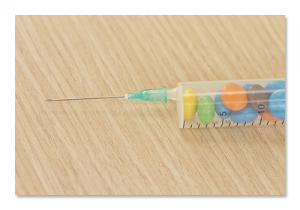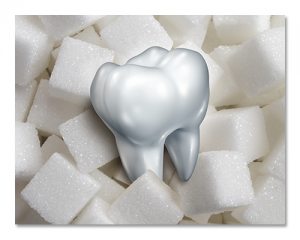Ditch Sugar Cravings with These 5 Strategies
“I had done so well yesterday, but about 9 p.m. last night I walked into the kitchen and there they were,” a friend recently told me. “I intended to eat just a bite, but, well, I managed to polish off quite a few cookies. It was like something overcame me and I just couldn’t stop!”
The root cause of cravings runs the gamut from ancestry to lifestyle choices. Knowing what type of cravings you have could be the key that finally helps you break free of your sugar addiction.
Genetics certainly can play a role. We all have sweet-seeking behavior as part of our evolutionary beginnings, but cravings could be part of your unique genetic wiring. If you’ve got a sweet tooth, you know it.
Just one change to a single gene could explain why you break into a sweat trying to resist dessert, while your friend could care less about the hot lava cake topped with whipped cream.
Research shows a difference in DNA could mean some people are less sensitive to the taste of sugar, so they chase sweeter and sweeter foods to get the reward— foods the average person would find way too sweet.
Besides genetics, a high-sugar impact diet can create and exacerbate cravings. High-sugar impact foods give you quick energy, but ultimately set off a vicious cycle of cravings for the very foods that create cravings.
While these two sources of cravings may seem pretty far apart, your body responds the same way. Insulin spikes and blood sugar dips that come on the heels of eating sugar throw your hormones and defense system all over the place.
You may not even be aware you’re eating that much sugar. Labels don’t make it easy to spot. Sugar hides in non-sugar sounding ingredients like maltodextrin, barley malt, and fruit juice concentrate.
If you’re making all the right food choices and eating healthy but still deal with cravings that create weight loss resistance and numerous symptoms, these five strategies can help you curb those cravings to claim fast, lasting fat loss and optimal health you deserve.
- Reduce stress levels. While sometimes sugar cravings are a result of low blood sugar, cravings strike even when you’re not hungry. We turn to food for comfort when we’re stressed or upset, and not wild salmon or grass-fed beef. Instead, we crave sugar. Ironically, sugar actually stresses your body further, shooting it full of short-term energy, sending your hormones into a spin cycle, and spiking and then plummeting your blood sugar. To crush cravings, manage your stress levels with yoga, meditation, deep breathing, or whatever helps you unwind and relax.
- Make lateral shifts. You probably recall a time you adamantly resisted your aunt’s homemade pound cake only to later devour two during a late-night kitchen raid. Rather than tell yourself no, opt for lateral shifts, or just-as-delicious but healthier alternatives for your favorite foods. A little dark chocolate with almond butter will knock out any dessert craving, and faux-tatoes (mashed cauliflower with ghee and salt) make a smart alternative to high-sugar impact mashed potatoes. Be creative and any favorite food can become a lateral-shift opportunity.
- Get 7 to 9 hours of sleep. It’s no coincidence you’re craving your coworker’s homemade brownies after a crappy night’s sleep. Beyond just making you a caffeinated morning-after mess, inadequate slumber knocks numerous hormones out of whack, paving the road for hunger, cravings, and overeating. You want to prepare for quality, uninterrupted sleep. About an hour before bed, turn off electronics and develop an unwinding bedtime ritual like a hot bath, chamomile tea, and a good (but not great) novel.

- Don’t eliminate sugar all at once. Completely eliminating sugar at once guarantees you’ll go into withdrawal, like you would with any addiction. Instead, you want to taper and transition, nice and easy, from high-to medium-to low-sugar impact foods. It’s a process that sets you up for success and prevents the cravings that can set you back. In my Sugar Impact Diet, I provide three cycles to help you effortlessly and permanently transition off sugar. I also give you strategies to help you fight symptoms that arise as you make the shift to low-sugar impact living. I’ll hold your hand and help you ease off the high-sugar impact foods that hurt you so you can seize the vibrant life that’s waiting for you! As you heal, you’ll eliminate cravings and retrain your taste buds to enjoy naturally sweet foods like slow-roasted almonds or vanilla.
- Stabilize your blood sugar with protein. One of the fastest ways to calm your sugar cravings is by eating protein. Protein is great for filling you up and keeping you satisfied, but did you know that it can actually decrease your cravings, too? It puts the brakes on our neuronal reward system, the brain chemicals that make us feel good and motivate us to get more food, even when we’re not hungry. When we’re low in protein, cravings take over and crack the whip in search of a quick fix. Smart protein sources include grass-fed beef, wild-caught fish, free-range poultry, and if you’re not intolerant, barnyard eggs. Vegans and vegetarians should focus on legumes, nuts and seeds, and slow low carbs like quinoa for optimal protein.
Crushing your sugar cravings begins with healthy, blood sugar-stabilizing foods. I want to show you how easy, flavorful, and delicious low-sugar impact eating can be.
That’s why I’m inviting you to a Cook-A-Thon that my good friend JJ Virgin is hosting, where you’ll join five celebrity health experts and me to answer YOUR questions LIVE and reveal delicious low-sugar impact recipes for losing weight fast.
Among those strategies, you’ll learn how to throw together delicious meals, shakes, and yes, desserts – including craving-crushing cookies!
This Cook-A-Thon will blow your mind how tasty and delicious losing weight fast can be!
Join us as we show you how to tame your cravings and create delicious, fat-burning recipes in this exciting, fun, FREE event. To claim your spot for the Sugar Impact Cook-A-Thon, simply click here.

References
Yanovski S. Sugar and fat: cravings and aversions. J Nutr. 2003 Mar;133(3):835S-837S.
